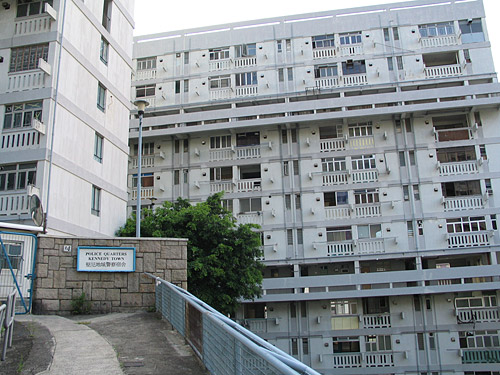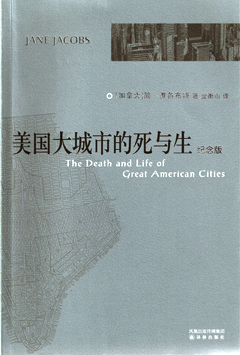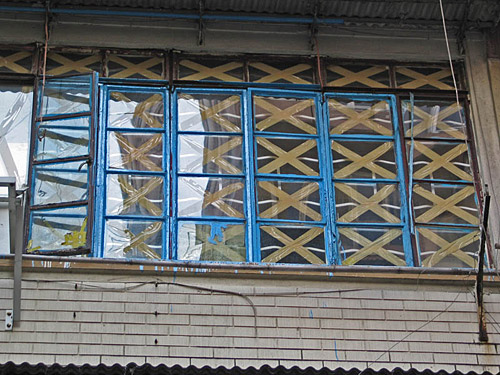Listening to Jane Jacobs in New York and Hong Kong
Lawrence PUN has authored three novels, most recently ‘The Lost Land’ (2005), and a number of non-fiction works. Among his awards are the Hong Kong Youth Literary Award, a Chinese Literature Creative Award, and the 7th Hong Kong Chinese Literary Biennial Award. His fiction appears regularly in journals and anthologies in Hong Kong and mainland China. He currently teaches creative writing at the Chinese University of Hong Kong. His website and blog are at www.lawpun.com and http://blog.sina.com.cn/lawpun

ving lived in Hong Kong for thirty-some years, I came to US in June 2007 for a one-year artist grant funded by the Asian Cultural Council. Besides participating in a fall residency at the International Writing Program at the University of Iowa, I spent much of my time in New York focusing on urban cultures. Another grantee residing here once mentioned to me that the “culture shock” experienced by him is not that “great”, hinting that NYC and HK just look too “similar” to him. This is not inaccurate, but I agree with him on a surface level only. Yes, both place have skyscrapers, vertical city, high density, unstoppable gentrification, the privatization of social life by consumer culture, assorted/ uneven/ detoured pathways – let’s just limit ourselves to one single aspect of urban space. However, once you look closely, subtle but conspicuous differences lie in all these apparent “similarities”, from the quality of public space, the development of hybrid architectural styles, to the preservation of historical landmarks, neighborhoods, and communities. Looking at Hong Kong from the vantage point of New York, I draw some observations to reflect back on my home town. This essay is one among many.
I recently visited an exhibit called Jane Jacobs and the Future of New York, from which I learned more about Jacobs’ stories of urban protest and her close relationship with the New York City of the past, the present and the future (her seminal work, Life and Death of the American City, published in 1961, was dedicated to the city of New York). But Jane Jacobs’ significance and influence transcended New York City long ago. Anyone concerned with urban life, planning or development can’t help but encounter her name.
Some years ago, when I learned of the government plan to raze my childhood birthplace to make way for Route 7, I felt genuinely perplexed. Though I’m not sure if “perplexed” is the most suitable word. What I felt was a more personal loss-- to know that a place I had lived from birth to adolescence will soon be dismantled and no longer there for me to revisit. Separate from my personal loss, this place is also another kind of housing arrangement waning on a larger scale, a result of changing fringe benefits earned by the civil servants in the postcolonial era – a policemen’s quarter. Today, the Route 7 proposal is still under discussion, but the sky at the site is already circled in by wire netting and completely. blocked off. The complex has long ago now entered a state of “soft disappearance”.
I hadn’t read Jacobs’ work at the time, nor did I know that this “street aunt” had not only written books, but also practiced what she preached as a political activist. Several of the large-scale protests for which she was responsible involved the encroachment of highways on cities. As early as 1958, for example, before she began writing seriously, Jacobs opposed a plan that called for the extension of a road through Washington Square Park. Another, more significant victory came shortly after the release of her first book, when Jacobs led a successful campaign to overturn the “Lower Manhattan Expressway” commissioned by Robert Moses in the early 1960’s. This master plan, commonly known as "LoMEx,” conceived of a superhighway that would stretch from east to west across Manhattan, from the Hudson River to the East River. If the plan had been carried out, Manhattan’s Little Italy and SoHo Districts would never have flourished as they have today.

Today, as the Star Ferry Pier and Queen’s Pier have given way to the P2 highway, the colonial-style Yau Ma Tei Police Station is “hanging by a thread?” because of the Central Kowloon Subway Route; the Cross Street and Tai Yuen street markets in Wan Chai are at risk of being torn down, all “in the name of traffic”, we realize again that the stories of the “Battle Between People and Cars” Jane Jacobs fought several decades ago are not relics of the past. Her rallying cry—“Downtown is for the people, not for cars!”—still resonates. As some commentators have accurately suggested, though the Chinese translation of The Death and Life of American Cities was very late arriving (it wasn’t published until 2005), its significance hasn’t diminished one bit. On the contrary, the book seems entirely appropriate, even revelatory, for today’s China, a country in which the wheels of redevelopment roll swiftly forward even as the country mockingly refers to itself as “Chai-Nah” (“Dismantle that,” or “Tear-it-down” in Chinese).
The battle between people and cars is merely a symptom, however, not the root cause of this conflict. The real target of Jane Jacobs’ questions and attacks was the top-down urban planning logic that prevailed over all dissenting views. This logic, grounded only on empty, abstract ideas, called for the zoning and segregation of cities, the dissemination of integrated neighborhoods into suburban satellites connected by scattered highways, and the use of a “bulldozer approach” to urban renewal. This often meant tossing out the existing tenants, tearing down the existing buildings, and transforming the area into a large-scale housing estate with rows of identical dwellings. As modernist architecture swept across America in the 1950’s and 1960’s, Jacobs, a journalist with no college degree, challenged a group of urbanists, architects, engineers, lawyers and real estate developers, all of whom held modernism up as the unarguable truth. Jacobs’ story really is a little like the story of David fighting the giant Goliath. This giants’ group included among others Robert Moses, the undisputed “master builder” of mid-century New York City, architectural critic Lewis Mumford and Le Corbusier, European sage of modern architecture, How Moses himself felt about Jacobs can be glimpsed from a note included in the show.
The core of the “Radiant City” Le Corbusier advocated is made up of homogenous, high-density skyscrapers, where pedestrian streets are eliminated and replaced with on one hand highways and on the other parks --the areas intended for human activity that make up the vital low-density “green zone.” Today, rereading his work makes me genuinely feel like I am reading in a “Madman’s Diary”. Take, for example, some quotes from The City of Tomorrow: “Decorative art is dead. Modern town planning comes to birth with a new architecture. By this immense step in evolution, so brutal and so overwhelming, we burn our bridges and break with the past.” In another section, he writes, “The modern street in the true sense of the word is a new type of organism, a sort of stretched-out workshop, a home for many complicated and delicate organs, such as gas, water and electric mains.” Le Corbusier interprets straight lines, right angles, and standardized machine aesthetics of modernism --absolute exactitude--as the basic principles of human behavior.

At stake was not only commercial benefit, but also a kind of feverish idealism, an obsession with the construction of an impassioned utopia. But two dramatically different visions of “the ideal” may emerge. Where you may see a hybrid street as ideal, he would have regarded it as a malignant tumor. The garden city and vertical city he considers perfection you may regard as nothing more than a ruin . Comparatively speaking, the grand “Eden-like” visions described today on Hong Kong construction-site signboards (“People-Oriented,” “Environmentally Sound,” “Revitalizing the Community”, “Preserving Our History”) all seem more like the feel-good rhetoric of overpowering capitalism. Does anyone really want to live among the infinite surroundings of walls of buildings—the tall residential blocks built without setbacks, a favorite of 1990s real estate developers in search of maximum profit, among mega-malls and chain stores? We are living in a reality we do not believe in.
In The Death and Life of American Cities, Jacobs offers four principles for maintaining urban vitality: mixed use, a dense street network, building variation, high concentration. Only the application of these principles will enliven, she says in a celebrated phrase, the “ballet of the sidewalks”. Jacobs offers no grand theories: everything she advocates derives from a single phrase—“Please Look Closely”. Her starting point is the meticulous observation drawn from daily life. But in addition to her abilities as author and urban observer, Jacobs’ role as a political activist should not be overlooked. She established a powerful model for ongoing protest movements involving urban planning issues by employing basic organizational tools that activists continue to use today: forming coalitions, organizing meetings, circulating petitions, starting letter-writing campaigns, appealing directly to the mayor, using the power of the media, and initiating legal action like unfair-termination lawsuits. In addition, Jacobs’ method involved turning from defensive protest to proactive planning with civic participation. These sorts of success stories are not lacking elsewhere abroad. The H15 dumbell plan proposed by a group of Wanchai citizens marks a starting point for Hong Kong, though the road before us is still long and full of obstacles. The once prosperous Lee Tung Street in Wanchai, colloquially named the "Printing Street" or the "Wedding Card Street" after the business done there, became a dead street as a result of the government's top-down urban renewal plan called the “H15 proposal.” To preserve the street, a counter-proposal called the "H15 dumbbell plan" was submitted by a group of local residents, marking the first-ever urban planning proposal drawn up by Hong Kong citizens.
If China really is a “tear-it-down” state where the wrecking ball can be fired overnight by top authorities, the aegis of “One Country Two Systems,” meaning the interplay of tradition and modernity, seems to offer a more sophisticated model for Hong Kong. The city has her own legal system which urban planners and developers have to conform to. Not only the formal procedures but the government, too, has to take into consideration public sentiment, being a supposedly civil society where the right of social protests is guaranteed. Though economically inclined, Hong Kong just can’t join in the Chinese “golden age of development” without further ado. In fact, the people of Hong Kong people have developed a heightened awareness about collective memory, historical awareness and urban renewal participation in recent years. Urban space has become a territory where all sorts of powers battle each other – preservationists, leftists, rightists, urban planners, the government, the plebeians, the moguls and… Thus, while Hong Kong’s urbanscape keeps changing all the time, the process is more a “melting-down” rather than a “tear-it-down.” And that is why quite many places in Hong Kong are in a state we could call “soft disappearance” – a gradual process of dissolution, slow enough to be perceived without being lamented.
Translated from the Chinese by Michael Judd
Michael Judd is a graduate student in poetry at the Iowa Writers Workshop. He studied Economics and English at Princeton and at Brigham Young University. His awards include an Academy of American Poets Undergraduate Prize, the Mayhew Prizes in Poetry and Short Fiction, and a Ruth Lilly award in fiction. From 2001 to 2003 he was a church missionary in Hong Kong.
6.1 Spring 2008
- Editorial
-
SPECIAL SECTION: NON-FICTION NOW
-
A MALAYSIAN BOOKSHELF
-
VAN CAM HAI
-
LAWRENCE PUN
-
PUJA BIRLA



